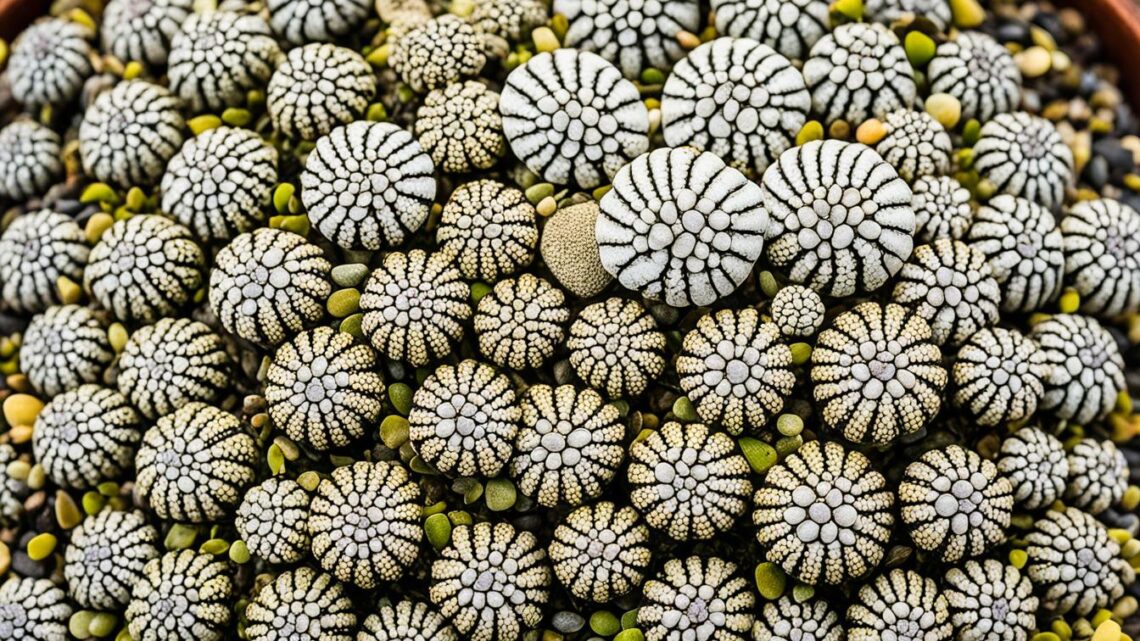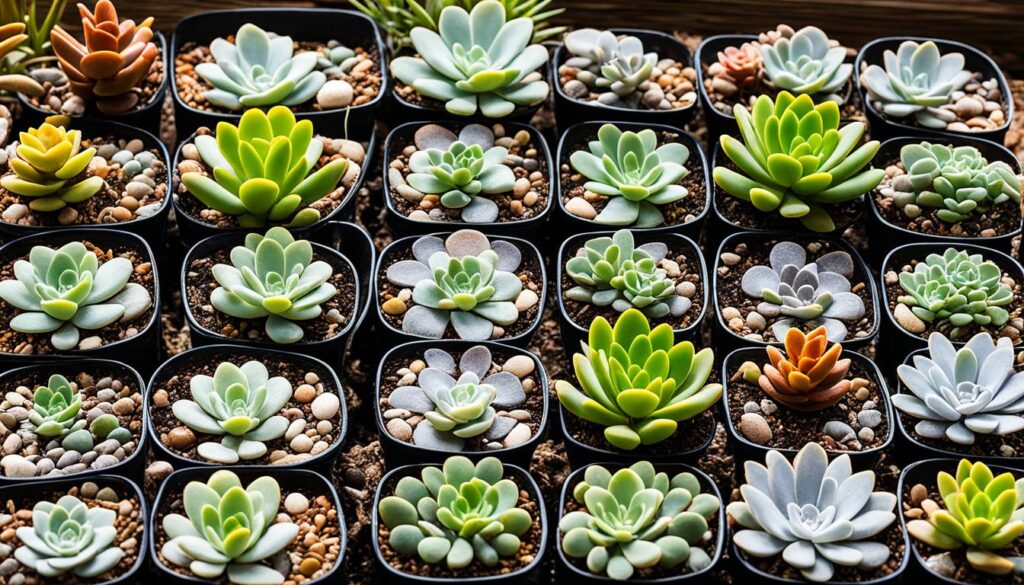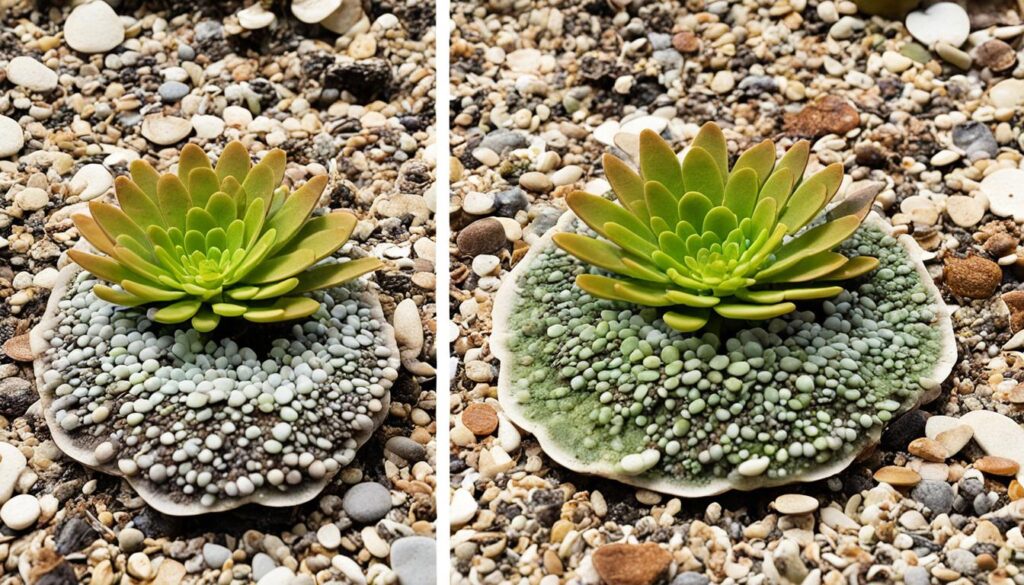
Have you ever seen a plant that’s more like a pebble than a living thing? Meet Lithops gracilidelineata, known as «living stones». They charm plant lovers worldwide. These succulents come from Southern Africa. They mimic rocks, making them a standout in gardens. But how to care for these «pebble plants«? Let’s explore the complete care guide for Lithops gracilidelineata.
Introduction to Lithops gracilidelineata
Botanical Name and Common Names
Lithops gracilidelineata is known as «living stones» or «pebble plants.» They are part of the Aizoaceae family, which has unique succulents. Their stone-like look makes them well-adapted to their environment, and they are often seen as «living fossils.»
Native Habitat and Characteristics
These plants are from South Africa’s dry areas. Lithops gracilidelineata can survive long droughts due to their water-storing roots. They look like pebbles, which helps them hide in their rocky homes.
Lithops gracilidelineata is mentioned to have specific head sizes and leaf textures. Its colors and markings differ, showing a wide variety within the genus. They even have different flowers.
In 1922, Dr. Nicholas Edward Brown named the Lithops genus. Each Lithops species, including Lithops gracilidelineata, has its own look. They live in South Africa on quartz outcrops.
Lithops gracilidelineata Care Requirements
Lithops gracilidelineata are a type of Lithops succulent that don’t need much water. They’re great for people who love plants but forget to water them. To keep your Lithops healthy, you must pay attention to their light, temp, and soil.
Light Needs
Plenty of light is vital for Lithops gracilidelineata. They need at least 6 hours of direct sun a day. A sunny windowsill or a greenhouse is perfect for them. Don’t put them in the shade, or they might stretch and not make many flowers.
Watering Requirements
Lithops gracilidelineata hate too much water. They actually do best when they’re almost dried out. In their active times, water them when the soil has fully dried up. Always make sure they aren’t sitting in water. Too much water can cause them to rot.
Temperature Preferences
They like it warm, from 50 to 85°F during the day. At night, a bit cooler from 45 to 65°F is better. Don’t put them where it gets too hot or cold suddenly. This can stress them out.
| Lithops gracilidelineata Care Requirements | Optimal Conditions |
|---|---|
| Light | Direct sunlight for at least 6 hours per day |
| Watering | Water only when soil is completely dry |
| Temperature | 50-85°F (10-29°C) during the day, 45-65°F (7-18°C) at night |
To keep your Lithops gracilidelineata happy, make sure they get the right amount of light, water, and the right temp. These plants are easy to care for and do well in and out of the house. They are really unique plants that need water only sometimes.
Soil and Potting Considerations
The base of caring for your Lithops gracilidelineata is the perfect soil and pot setup. They need a sandy, rocky soil that drains well. This is like the natural sandy places they come from in southern Africa.
Well-Draining Soil Mix
For a Lithops gracilidelineata, use a cactus or succulent mix with ingredients like sand, perlite, or crushed rock. Create perfect soil by blending in these materials. Good drainage is key to avoid too much water and root rot.
Pot Selection and Repotting
Choose a pot that’s wide and shallow for your Lithops gracilidelineata. It fits their deep taproot well. A pot 3-5 inches deep is usually good. Unglazed terracotta pots help get rid of extra moisture.
Lithops gracilidelineata don’t need to be repotted often because they grow slowly. They actually like being a bit cramped. This can help them bloom. When you do need to repot, do it carefully to keep their roots safe.
The key to a healthy Lithops gracilidelineata is the right soil and pot. With proper care, these unique plants will do well in your home or garden.
Light and Temperature Needs
Lithops gracilidelineata, or living stones, love environments like their desert home. They need a lot of direct sunlight to stay colorful. Shaded places make them grow long and dull.
They do best with 4-5 hours of direct sunlight daily. Morning and late afternoon sun are great. This avoids the hot, midday sun.
Optimal Light Exposure
Lithops do well in a range of 65°F to 80°F. They handle highs around 90°F to 100°F too. But too much heat can harm their unique shapes and colors.
Be careful with cold, as they can’t survive frost. Inside, keep them somewhere with even, moderate temperatures. This is more like their desert home.
Temperature Tolerance
Know what Lithops need for light and temperature. This helps these amazing plants grow well. It works whether you keep them outdoors or indoors.

Watering Schedule for Lithops gracilidelineata
Lithops gracilidelineata, or «living stones,» are easy to care for because they can survive without water for a long time. They do have specific water needs for best growth and health.
In their growing seasons, which are the spring and fall, water these plants sparingly. Let the soil dry out completely between waterings. This helps them avoid problems like root rot from too much water.
During their dormant times, in summer and winter, they need even less water. It’s important to stop or lessen watering to prevent harm. Watering too much during this time can cause root rot and fungal infections.
- During the active growth phase (spring and fall), water Lithops gracilidelineata sparingly, allowing the soil to dry out completely between waterings.
- During the dormant phase (summer and winter), reduce or completely stop watering to prevent overwatering and root rot.
- Monitor the plants closely and adjust the watering schedule based on the plant’s appearance and the environmental conditions.
Following this watering schedule keeps your Lithops in good health with good drought tolerance. It’s better to water them less than more. These plants are quite unique.
Dormancy and Growth Cycle
Lithops gracilidelineata, known as living stone plants, have a unique cycle tied to the seasons. In summer and winter, they go dormant. During this time, their old leaves fall off. The plant uses this energy for new growth, seen in spring and fall.
Seasonal Dormancy Periods
It’s important not to water Lithops gracilidelineata while they are dormant. Overwatering can harm them by causing root rot. Following the plant’s natural dormancy cycle is key for its health. This lets the Lithops rest and prepare for new growth.
New Leaf Growth and Old Leaf Absorption
In their growth periods, Lithops gracilidelineata shows “leaf splitting.” This is where new leaves push old ones apart. The plant absorbs the old leaves. This gives it nutrients for fresh growth. The process of old leaves turning into new ones is a beautiful part of these plants.

Growing Lithops gracilidelineata successfully means understanding their growth and rest phases. By caring for them properly and letting them follow their natural cycle, these stunning plants thrive.
Propagation Methods
The Lithops gracilidelineata, or «living stone,» can grow from seeds or by dividing the plant. This gives gardeners a chance to add these amazing succulents to their garden. It’s a fun way to grow your succulent collection.
Seed Germination
Collect tiny seeds from Lithops’ white flowers to start growing them. Plant these seeds in a special soil mix for succulents that drain well. It’s important to watch the light, temperature, and how much water the seedlings get to help them grow successfully.
Division
To divide mature Lithops, separate the rosettes carefully at the roots. This is best done in spring when the plant is growing fast. Put each rosette in its own pot with proper soil, light, and water. This helps them grow strong as they become new independent plants.
Both methods of growing Lithops gracilidelineata need gentle care. With good knowledge of how to propagate and care for them, you help these unique succulents live on. It’s like art, learning how to make more of these living stones through propagation, seed germination, division, and cloning.
| Propagation Method | Description | Success Factors |
|---|---|---|
| Seed Germination | Collecting and sowing Lithops seeds | Well-draining soil, appropriate light and temperature |
| Division | Separating individual rosettes at the roots | Careful division in the spring, proper potting and care |
Common Pests and Diseases
Lithops gracilidelineata, also known as living stones, are tough plants. But they can get pests and diseases if the soil is too wet. It’s key to know how to spot and manage these issues to keep your plants healthy.
Identifying and Treating Pests
The top pests for Lithops gracilidelineata are spider mites, mealybugs, and scale insects. Look for web-like structures, cottony masses, or hard, raised bugs on your plant. To get rid of them, use diluted rubbing alcohol or insecticidal soap carefully, so you don’t hurt the plant.
Preventing and Managing Diseases
Root rot is the main sickness these plants face. It comes from too much water or bad soil drainage. Fungal growth can also show up if it’s too damp. To stop these diseases, make sure the soil drains well. Don’t water too much, especially when the plants are resting.
| Pest or Disease | Identification | Treatment |
|---|---|---|
| Spider Mites | Small, web-like structures on the plant’s surface | Diluted rubbing alcohol solution or insecticidal soap |
| Mealybugs | Cottony masses on the plant | Diluted rubbing alcohol solution or insecticidal soap |
| Scale Insects | Raised, hard-shelled insects on the plant | Diluted rubbing alcohol solution or insecticidal soap |
| Root Rot | Discolored, mushy roots and stem base | Improve soil drainage, avoid overwatering |
| Fungal Growth | White or discolored fungal growth on the soil or plant | Improve soil drainage, avoid overwatering |
Toxicity and Safety Considerations
Lithops gracilidelineata are safe for humans and pets. African children have actually eaten these unique plants when thirsty. But, if you put any chemicals on them, they might become toxic.
It is smart to keep these plants away from kids and pets. They might look interesting, but their odd shape and feel can attract little hands. So, put them where children and pets can’t get to them easily.
While these plants are mostly safe, being careful is always a good idea. Just use common safety sense for pets and humans. Then, you can enjoy these beautiful and safe succulents without any fears.
To wrap up, Lithops gracilidelineata are a good choice for families with kids or pets. Just make sure not to put harmful chemicals on them. With a little care, you can have these unique plants at home safely.
Unique Features of Lithops gracilidelineata
Lithops gracilidelineata look almost like stones. This helps them hide in desert areas perfectly. They grow very slowly and love dry places. Their deep roots and water-storing leaves help them survive.
In the fall and winter, Lithops gracilidelineata bloom with white, yellow, or orange flowers. This is when they show their beauty. Their ability to look like rocks and then have such pretty flowers is amazing.
Lithops gracilidelineata truly stand out in any collection. Their looks and how they adapt is really special. If you enjoy succulents or are just starting, they will amaze you. These plants are not just interesting, but also very beautiful.



